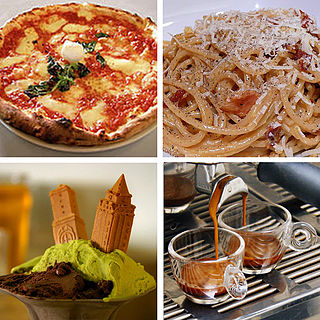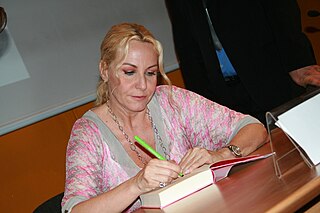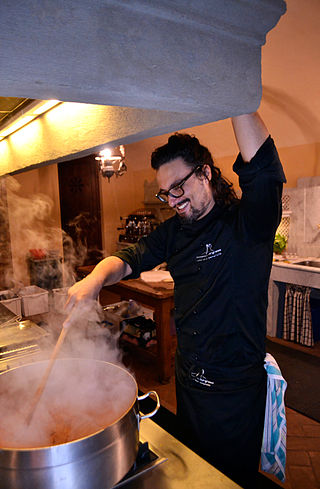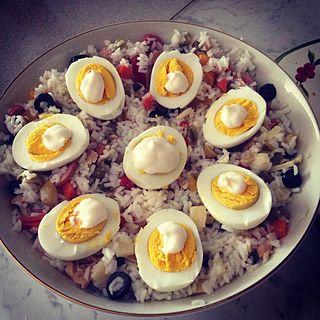
Carbonara is a pasta dish made with fatty cured pork, eggs, hard cheese, salt, and black pepper. It is typical of the Lazio region of Italy. The dish took its modern form and name in the middle of the 20th century.

Risotto is an Italian rice dish cooked with broth until it reaches a creamy consistency. The broth can be derived from meat, fish, or vegetables. Many types of risotto contain butter, onion, white wine, and Parmesan cheese. It is one of the most common ways of cooking rice in Italy. Saffron was originally used for flavour and its signature yellow colour.

Arancini, also known as arancine, are Italian rice balls that are stuffed, coated with breadcrumbs and deep-fried. They are a staple of Sicilian cuisine. The most common arancini fillings are al ragù or al sugo, filled with ragù, mozzarella or caciocavallo cheese, and often peas, and al burro or ô burru, filled with ham and mozzarella or béchamel sauce.

Cacciatore refers to a meal prepared with onions, herbs, usually tomatoes, often peppers, and sometimes wine. It is typical of the Italian cuisine.

Italian cuisine is a Mediterranean cuisine consisting of the ingredients, recipes and cooking techniques developed in Italy since Roman times and later spread around the world together with waves of Italian diaspora. Significant changes occurred with the colonization of the Americas and the introduction of potatoes, tomatoes, capsicums, maize and sugar beet—the latter introduced in quantity in the 18th century. It is one of the best-known and most appreciated gastronomies worldwide.

Spaghetti and meatballs is an Italian-American pasta dish consisting of spaghetti, tomato sauce and meatballs.
Sugolo is a dessert prepared with the must of red grapes, flour and sugar, cooked slowly and then left to cool. It can be served cool, like a pudding, or preserved in a jar like jam. It is a typical dessert in northern Italy.

Ribollita is a Tuscan bread soup, panade, porridge or potage made with bread and vegetables, often from leftovers. There are many variations, but the usual ingredients include leftover bread, cannellini beans, lacinato kale, cabbage and inexpensive vegetables such as carrot, beans, chard, celery, potatoes and onion. It is often baked in a clay pot.

Rai Gulp is an Italian free-to-air television channel owned and operated by state-owned public broadcaster RAI. It is the company's television channel for early teenagers, and is known for its programming for children between the ages of eight and fourteen.

Antonella Clerici is an Italian television host and journalist. She's the fourth woman to have presented Sanremo Music Festival, after Loretta Goggi, Raffaella Carrà and Simona Ventura

Rai Fiction is an Italian production company founded in 1997. Owned and operated by Radiotelevisione Italiana (RAI), the national broadcasting company of Italy, the company produces content for Rai's channels, producing animations, sitcoms, and other programmes. Rai Fiction also works in association with foreign production studios and TV channels as well as other production companies in Italy.

Gnudi, also called malfatti, are gnocchi-like dumplings made with ricotta cheese and semolina instead of potato flour. The result is often a lighter, "pillowy" dish, unlike the often denser, chewier gnocchi. Gnudi is the Tuscan word for "naked", the idea being that these "pillowy" balls of ricotta and spinach are "nude ravioli", consisting of just the tasty filling without the pasta shell.
This is a list of Italian television related events from 1964.

Vincisgrassi, also spelled vincesgrassi, is a typical Marche pasta dish similar to lasagna, considered one of the gastronomic emblems of the Marche cuisine.
Prescinsêua is a variety of cheese typical of the province of Genoa in the region of Liguria in Italy. In Italian it is also referred to as quagliata or cagliata. It is recognised by P.A.T. .

The pizza di Pasqua, in some areas also called crescia di Pasqua, torta di Pasqua, torta al formaggio or crescia brusca, is a leavened savory cake typical of many areas of central Italy based on wheat flour, eggs, pecorino and Parmesan. Traditionally served at breakfast on Easter morning, or as an appetizer during Easter lunch, it is accompanied by blessed boiled eggs, ciauscolo and red wine or, again, served at the Easter Monday picnic. Having the same shape as panettone, the pizza di Pasqua with cheese is a typical product of the Marche region, but also Umbrian. There is also a sweet variant. The peculiarity of this product is its shape, given by the particular mold in which it is leavened and then baked in the oven: originally in earthenware, today in aluminum, it has a flared shape.

Alessandro Borghese is an Italian celebrity chef. His mother is the German-American actress Barbara Bouchet.

Ligurian cuisine consists of dishes from the culinary tradition of Liguria, a region of northwestern Italy, which makes use of ingredients linked both to local production, and to imports from areas with which, over the centuries, the Ligurians have had frequent trade.

The cuisine of Basilicata, or Lucanian cuisine, is the cuisine of the Basilicata region of Italy. It is mainly based on the use of pork and sheep meat, legumes, cereals and vegetables, with the addition of aromas such as hot peppers, powdered raw peppers and horseradish. The local gastronomy is, for historical-cultural reasons, typically peasant, based on simple recipes and on the culture of reuse, in particular of meat and bread.

Insalata di riso, also known as riso freddo, is a typical Italian dish consumed during the summer, consisting of rice and other ingredients.















